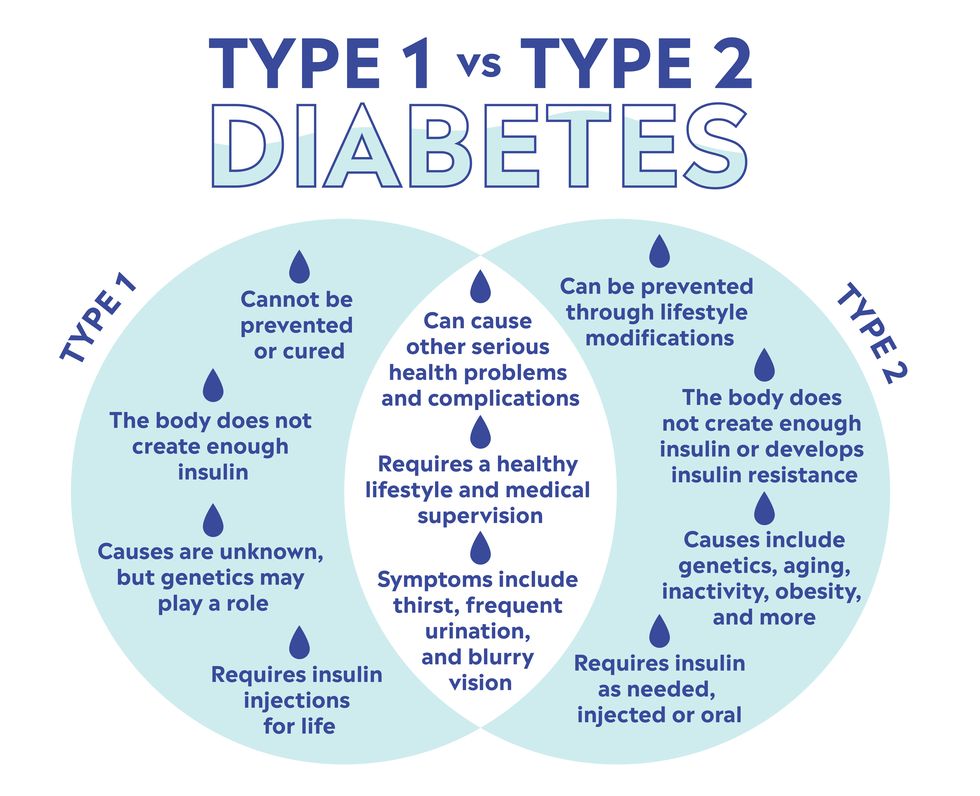According to the CDC, 34.2 million people have diabetes (10.5% of the US population).
What is Diabetes?
Diabetes is a chronic (long-lasting) health condition that affects how your body turns food into energy. Most of the food you eat is broken down into sugar (glucose) and released into your bloodstream. When your blood sugar goes up, it tells your pancreas to release insulin. Insulin allows the blood sugar into your body’s cells to use as energy.

Type 1 diabetes (previously known as insulin-dependent, juvenile or childhood-onset) is characterized by deficient insulin production and requires daily administration of insulin. Neither the cause of Type 1 diabetes nor the means to prevent it are known. Symptoms include excessive excretion of urine (polyuria), thirst (polydipsia), constant hunger, weight loss, vision changes, and fatigue. These symptoms may occur suddenly.
Type 2 diabetes (formerly called non-insulin-dependent, or adult-onset) results from the body’s ineffective use of insulin. The majority of people with diabetes have type 2 diabetes. This type of diabetes is largely the result of excess body weight and physical inactivity. Symptoms may be similar to those of type 1 diabetes, but are often less marked. As a result, the disease may be diagnosed several years after onset, after complications have already arisen.
How can Acupuncture help those with Diabetes?
In combination with pharmaceutical treatment with your primary care provider, acupuncture can help with the following:
- improve blood glucose management
- help with weight loss
- protect pancreas islet function, which is responsible for insulin production
- improve insulin resistance
- adjust the balance of hormones that affect diabetes
Three separate studies have shown that acupuncture can help with glucose and insulin levels, insulin sensitivity and resistance, and is helpful when combining with western medicine. In each of these studies the results showed glucose lowering effects and greater insulin sensitivity. For more information on these studies visit Medical News Today.
Other Healing Options
Depending on the depth of the symptoms, most diabetics who decide to eat and live in harmony show a significant improvement within at most a few months. Eating a wide sampling of foods from the following list strengthens the pancreas, regulates blood sugar, and at the same time improves the fluid metabolism. Diabetics should choose one or more of these foods daily as part of a primarily vegetarian diet of unrefined grains, vegetables, legumes, fruits, herbs, and a limited amount of nuts and seeds. In addition to diet, exercise helps to lower blood sugar levels and improves circulation, which tends to be poor in diabetics.
Examples of Foods Commonly Used in the Treatment of Diabetes
| Grains & Legumes | Vegetables & Fruits | Chlorophyll Foods | Herbs | Sweeteners | Animal Products |
| Rice Fresh Corn Whole wheat Tofu Garbanzo Beans | Carrot Asparagus Spinach Avocado Pear Grapefruit Blueberry | Spirulina Wheat or Barley Grass Chlorella | Dandelion Root Blueberry/huckleberry Leaf Cedar Berries | Licorice Tea or Powder Stevia Powder or Extract | Clam, Abalone Cow’s Milk/Yogurt Chicken or Goose Beef |
Prevention
Making a few changes to your lifestyle now could help you avoid serious health complications of diabetes in the future. These changes include:
- Losing weight and keeping it off.
- Following a healthy eating plan.
- Get regular exercise.
- Don’t smoke.
The American Diabetes Association provides a 60-second Type 2 Diabetes Risk Test, based on your results you will want to consult your doctor on what the next steps will be.
Call our office today to discuss how Acupuncture could help you!
Sources:
https://www.medicalnewstoday.com/articles/319618
https://www.prevention.com/health/health-conditions/a21764231/type-2-diabetes-definition/
Pitchford, P. Healing Foods with Whole Foods: Asians Traditions and Modern Nutrition. (3rd ed.)
